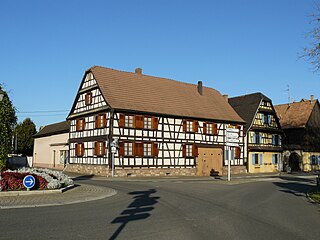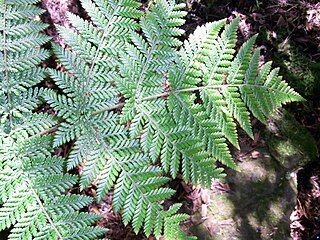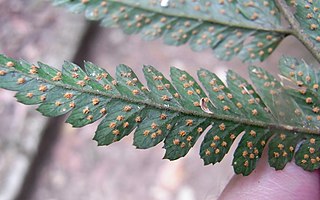
Pioneer species are hardy species that are the first to colonize barren environments or previously biodiverse steady-state ecosystems that have been disrupted, such as by wildfire.

A hardiness zone is a geographic area defined as having a certain average annual minimum temperature, a factor relevant to the survival of many plants. In some systems other statistics are included in the calculations. The original and most widely used system, developed by the United States Department of Agriculture (USDA) as a rough guide for landscaping and gardening, defines 13 zones by long-term average annual extreme minimum temperatures. It has been adapted by and to other countries in various forms.

Polystichum munitum, the western swordfern, is an evergreen perennial fern native to western North America, where it is one of the most abundant ferns in forested areas. It occurs along the Pacific coast from southeastern Alaska to southern California, and also inland east to southeastern British Columbia, northern Idaho and western Montana, with disjunctive populations in northern British Columbia, Canada; the Black Hills in South Dakota, United States; and Guadalupe Island off of Baja California, Mexico. Western swordfern is known to have locally naturalized in parts of Great Britain and Ireland.
Sword fern is a common name for several ferns and may refer to:

Polystichum acrostichoides, commonly denominated Christmas fern, is a perennial, evergreen fern native to eastern North America, from Nova Scotia west to Minnesota and south to Florida and eastern Texas. It is one of the most common ferns in eastern North America, being found in moist and shady habitats in woodlands, stream banks and rocky slopes. The common name derives from the evergreen fronds, which are often still green at Christmas.
Lastreopsis subrecedens is a species of fern in the family Dryopteridaceae. It is endemic to China. Its natural habitat is subtropical or tropical moist lowland forests. It is threatened by habitat loss.

Lastreopsis, known as shieldfern, is a genus of ferns in the family Dryopteridaceae, subfamily Elaphoglossoideae, in the Pteridophyte Phylogeny Group classification of 2016.

Argemone munita is a species of prickly poppy known by the common names flatbud prickly poppy and chicalote. "Munita" means "armed", in reference to the many long prickles. This flower is native to California, where it is widespread throughout the western part of the state and its eastern deserts, on slopes to 10,000 feet, and along roadsides. Its range also extends into Baja California, Arizona, and Nevada.

Boofzheim is a commune in the Bas-Rhin department in Grand Est in north-eastern France. Its name is probably derived from the French "bœuf". Variants of the name include Boofi - Boffesheim - Bofftsheim - Boffsheim - Bototzheim - Booftzheim - Booffzheim.

Kalmiopsis fragrans is a rare species of flowering plant in the heath family known by the common name North Umpqua kalmiopsis. It is endemic to Oregon in the United States, where there are just a few known populations, all within Douglas County.

Lastreopsis silvestris, known as the mountain shield fern, is a rare plant found in eastern Australia. The habitat is high altitude rainforest on the McPherson Range, on the border of the states of New South Wales and Queensland. The habitat has high rainfall; mists and fogs are frequent. The original specimen was collected by Cyril Tenison White in December 1918, he described them as being “very abundant”.

Parapolystichum microsorum, synonym Lastreopsis microsora, known as the creeping shield fern is a common small plant found in eastern Australia and New Zealand. The habitat is rainforest or moist sheltered eucalyptus forests. It may form large colonies. The specific epithet microsora translates to "small sori".

Macroschisma, common name the narrow slot limpets, is a genus of sea snails, marine gastropod mollusks in the family Fissurellidae, the keyhole limpets and slit limpets.

Lastreopsis nephrodioides is a fern in the family Dryopteridaceae. The specific epithet refers to its resemblance to Nephrodium decompositum R.Br..
Oenotrichia is a genus of ferns in the family Dennstaedtiaceae in the major group Pteridophytes, and was described as a genus in 1929. It is native to New Caledonia.

Euclidia munita is a moth of the family Erebidae first described by Jacob Hübner in 1813. It is found in Ukraine, south-western Russia, Kazakhstan, Tajikistan, Turkmenistan, Kyrgyzstan, northern Iran, Afghanistan, China and Mongolia.

Parapolystichum is a genus of ferns in the family Dryopteridaceae, subfamily Elaphoglossoideae, in the Pteridophyte Phylogeny Group classification of 2016. The genus is mainly native to the tropics, although its range extends to southeastern Australia.

Lastreopsis marginans, known as the glossy or bordered shield fern is a fern found in eastern Australia. The habitat is rainforest or wet sclerophyll forest. Fronds are crowded and erect, between 50 and 90 cm long, coloured a glossy dark green. The lectotype was collected near the Clarence River by Hermann Beckler.

Parapolystichum acuminatum, synonym Lastreopsis acuminata, is a small plant found in eastern Australia. Common names include creeping shield fern, glossy shield fern and shiny shield fern. It is a widespread fern, often seen in wet eucalyptus forest or rainforest, usually near streams.

Lastreopsis hispida, known as the bristly shield fern, is a common plant found in New Zealand. Less often seen in Australia, in cool rainforest areas with humus rich soils, or more rarely as an epiphyte on tree ferns or mossy logs. Listed as endangered in the state of New South Wales where it grows in a few remote sites in the Blue Mountains, such as at Mount Wilson. The specific epithet hispida is from Latin, meaning "bristly".
















